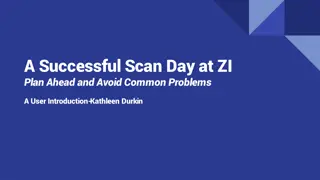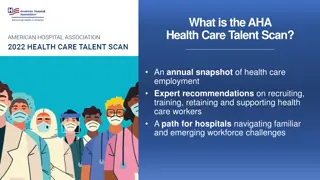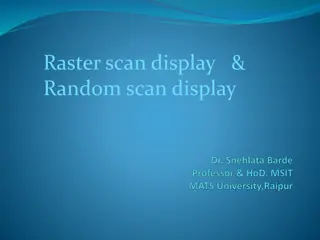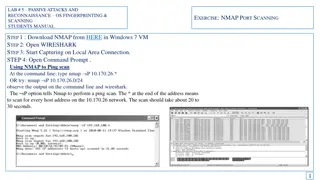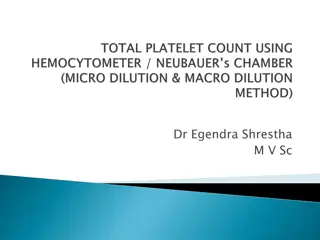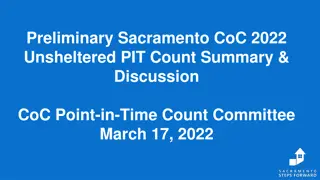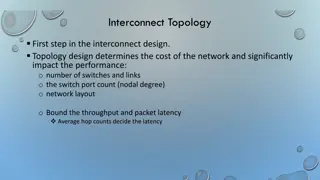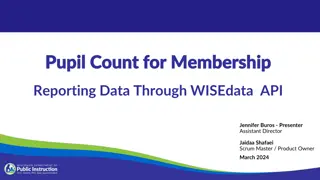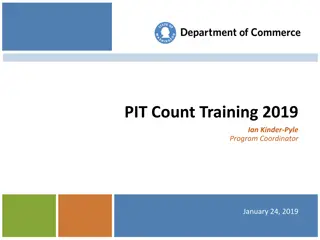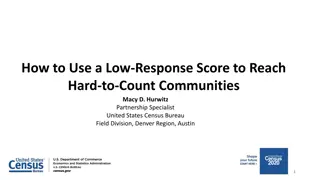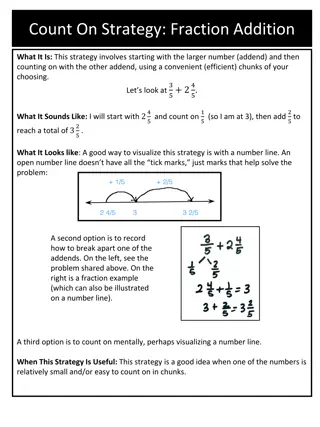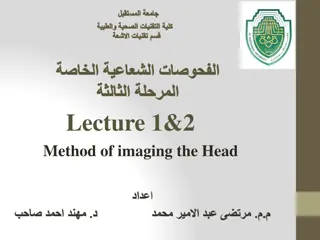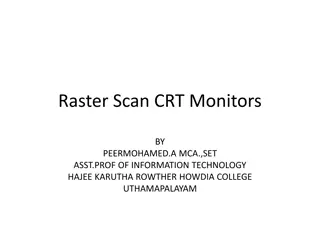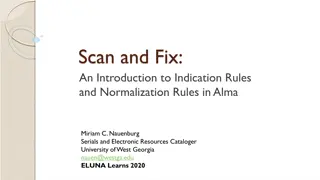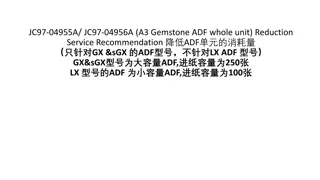Differential white blood cell count
Differential white blood cell count, also known as a leukocyte count, is a crucial test to determine the different types of white blood cells present in the blood. The cells are classified into granulocytes (neutrophils, eosinophils, basophils) and agranulocytes (lymphocytes, monocytes). Blood smear
3 views • 21 slides
Successful Strategies for a Smooth MRI Scan Day at ZI
Plan ahead and avoid common problems for a successful MRI scan day at ZI with tips on study setup, participant preparation, scheduling, reservation time management, and packing essentials. Ensure a smooth process by having the right team in place and following key steps outlined in this comprehensiv
0 views • 18 slides
Understanding Red Blood Cell (RBC) Count and Its Significance in Blood Health
Red blood cells, comprising nearly 45% of blood volume, play a crucial role in oxygen transport. The red blood cell count, measured as the number of cells per unit volume of blood, helps assess the adequacy of oxygen-carrying capacity. Normal values vary by age and gender. The experiment aims to det
8 views • 16 slides
Radiological Investigation of Hepatobiliary System and Imaging Modalities Overview
Exploring the hepatobiliary system through radiology, this lecture covers the anatomy, modalities like X-ray, Ultrasound, CT scan, MRI, and nuclear scan used for imaging, their advantages, disadvantages, and indications. It delves into the significance of liver, gallbladder, and biliary duct imaging
2 views • 37 slides
Insights from AHA Health Care Talent Scan for Thriving Workforce Planning
The AHA Health Care Talent Scan provides an annual overview of health care employment trends and expert recommendations for recruiting, training, and retaining health care workers. It addresses challenges in workforce planning, including clinician well-being, evolving education and training needs, a
0 views • 7 slides
Understanding Raster Scan Display and Random Scan Display Techniques
Raster scan display involves the electron beam moving along the screen in a systematic pattern to create an image, while random scan display directly draws pictures in any order. Raster scan is commonly used in devices like TVs and monitors, providing high color accuracy but may have lower resolutio
0 views • 9 slides
Passive Attacks and Reconnaissance using NMAP for Network Scanning
Learn how to use NMAP for passive attacks and reconnaissance through port scanning techniques like ping scan, TCP port scan, and stealth scan. Understand how to analyze the output in Wireshark to identify open ports and version numbers on target systems.
2 views • 7 slides
Understanding WBC Differential Count in Blood Analysis
WBC (white blood cell) count is essential in assessing a patient's health. A differential count helps determine the percentage of different types of white blood cells. This analysis can provide important insights into various health conditions like infections, allergies, and systemic illnesses. The
1 views • 9 slides
Methods for Determination of Microbial Growth
Quantitative determination of microbial growth is crucial for various purposes, with two commonly used methods being the standard plate count and spectrophotometric measurement. The standard plate count method estimates living microbial cell density, while spectrophotometric measurement relies on tu
2 views • 6 slides
Understanding White Blood Cell Count and Measurement Methods
White blood cell count measures the number of white blood cells in a specific volume of blood, indicating infection or disease progression. The normal range is 5000-11000 cells/cubic mm, varying with age. Methods include manual and electronic counting using specific instruments. Materials like antic
0 views • 14 slides
Understanding Platelet Count and its Importance in Blood Clotting
Platelets, also known as thrombocytes, play a crucial role in blood clotting. This article explains the structure and lifespan of platelets, the purpose of performing a total platelet count, and the principle of counting platelets using a hemocytometer. It also describes the components used for plat
0 views • 20 slides
Filling Polygons Using Scan Line Algorithm
Learn how to fill polygons using the Scan Line Algorithm, which involves intersecting scan lines with polygon edges and filling the area between intersections. Steps include finding Ymin and Ymax, intersecting scan lines with edges, sorting intersection points, and filling the interior of the polygo
0 views • 36 slides
Detecting Eye Diseases Early with OCT Eye Scan
Take care of both your vision and health with an OCT eye scan, which can detect diseases like Diabetes, Glaucoma, and Age-Related Macular Degeneration. Learn how this simple procedure works and why it's important to prioritize your eye health. Say yes to the OCT health check for your extraordinary e
0 views • 13 slides
Understanding Red Blood Cell Count Methods
Explore the principles, normal ranges, and conditions related to red blood cell count. Learn about the apparatus and materials needed for RBC counting, as well as the procedure involved. Understand how changes in RBC count can indicate various health conditions like polycythemia and anemia.
0 views • 27 slides
Estimation of Dead-Time Loss for Neutron Count-Rates
This study discusses the estimation of dead-time loss for high neutron count-rates and the associated multiplicity correction using multi-channel list-mode data. The numerical method for high count-rate dead-time correction in neutron multiplicity counting is described, focusing on the use of multi-
0 views • 6 slides
Point-in-Time Count of Unsheltered Persons Experiencing Homelessness - Volunteer Training Overview
Point-in-Time Count (PIT) is crucial for understanding and addressing homelessness. This volunteer training provides insights into counting unsheltered individuals, gathering demographic data, and why PIT counts are conducted. It emphasizes the importance of measuring trends, strategizing resource a
1 views • 40 slides
Sacramento CoC 2022 Unsheltered PIT Count Summary & Updates
Examining the preliminary findings of the 2022 Sacramento CoC Unsheltered Point-in-Time (PIT) count, this report discusses volunteer efforts, areas covered, and involvement of professional outreach partners. The document outlines future steps, including surveys, data analysis, and planning for the n
0 views • 12 slides
Overview of Fly and Trajectory Scans in Data Acquisition
Fly and trajectory scans in data acquisition involve software and hardware options for acquiring data while positioners move at constant speeds. Software fly scans enable periodic data acquisition triggered by software, while hardware fly scans rely on pulses from positioners. Hardware fly choices a
0 views • 14 slides
Understanding Interconnect Topology Design and Performance Metrics
Interconnect topology design plays a crucial role in determining the cost and performance of a network. Factors such as the number of switches and links, switch port count, network layout, throughput, packet latency, average hop counts, nodal degree, hop count, and diameter are essential considerati
0 views • 38 slides
Comprehensive Overview of Pupil Count Reporting in WISEdata API
This presentation covers the reporting requirements for pupil count membership data through the WISEdata API, including agenda details, an extended timeline, reasons for the pilot project, and insights into how the Pupil Count Module in WiSFiP works. It also discusses the reporting needs for 2024, t
3 views • 31 slides
Understanding PIT Count Training for Homeless Population
This content provides insights into the PIT Count Training 2019 aimed at understanding and addressing homelessness. It covers topics such as unsheltered and sheltered counts, individuals included and excluded in the PIT count, and strategies to address subpopulations. Additionally, it clarifies what
2 views • 18 slides
Strategies for Reaching Hard-to-Count Communities Using Low-Response Score
Explore how to leverage a low-response score to engage with hard-to-count communities effectively. Learn about ROAM mapping tool, the 2020 Census goal, and the significance of Low Response Score (LRS) in identifying areas for targeted outreach. Discover hard-to-count variables and how to utilize dat
0 views • 14 slides
Step-by-Step Guide for Processing Returns Using a Scan Gun
Learn how to process returns efficiently using a scan gun by following a detailed step-by-step guide. From logging in to adding return lines, deleting entries, and handling trackable items, this guide provides clear instructions alongside visuals for a smooth return process.
0 views • 10 slides
Efficient Strategies for Fraction and Decimal Addition and Subtraction
Utilize the Count On and Count Back strategies to simplify fraction and decimal addition and subtraction. Start with the larger number and count on with the other addend or break apart the subtrahend into manageable chunks. These visual and mental approaches enhance calculation efficiency and accura
0 views • 4 slides
Raster Graphics and Scan Conversion in Computer Graphics
This lecture covers various topics related to raster graphics and scan conversion in computer graphics. It includes issues with scan converting a line, generalized line drawing algorithms, and the midpoint circle drawing algorithm. Additionally, it explores deriving mathematical expressions for draw
0 views • 21 slides
Guide to Processing RFI Returns on the Scan Gun Menu
Learn how to efficiently process RFI Returns using the scan gun menu. Follow step-by-step instructions, including entering incident details, adding return lines, handling mistakes, and completing the return process seamlessly. Images accompany each step for visual guidance.
0 views • 19 slides
Methods of Imaging the Brain: X-ray, CT Scan, and MRI
Different methods of imaging the brain, including X-ray, CT scan, and MRI, offer non-invasive ways to study brain structure and function. X-rays measure tissue density, CT scans provide detailed cross-sectional images, and MRI produces 3D anatomical images. MRI, in particular, has become a vital too
0 views • 37 slides
Understanding the 2022 Point-in-Time (PIT) Count of Persons Experiencing Homelessness
Learn about the significance of the annual Point-in-Time Count (PIT) conducted to measure homelessness trends, the distinction between sheltered and unsheltered counts, the guiding principles of the count, its purpose, and the specific locations where unsheltered individuals may be found. Explore wh
0 views • 44 slides
Understanding Raster Scan CRT Monitors in Information Technology
Raster Scan CRT Monitors are a common graphical output device used in Information Technology. They consist of components like the electron gun, control electrodes, and phosphor-coated screen. The electron beam emitted uses electromagnetic fields to direct and focus on specific spots on the screen. T
0 views • 11 slides
Point-In-Time Count Strategies for Homelessness Assistance
Snapshot of homeless individuals in a community on a single day to plan services, measure progress, and identify needs, strengths, and gaps. Process involves selecting a PIT lead, forming a committee, training volunteers, and counting individuals in various settings. Differentiates between who to co
0 views • 32 slides
Scan and Fix: Indication and Normalization Rules in Alma
Introduction to indication rules and normalization rules in Alma Miriam C. Nauenburg's presentation on the scan and fix workflow. Learn about creating and applying indication and normalization rules, testing rules in the Metadata Editor, and organizing rules as private or shared.
0 views • 54 slides
Buckinghamshire Claimant Count Analysis March 2023
This report provides insights into the Claimant Count and Alternative Claimant Count in Buckinghamshire for March 2023. The data reveals an increase in the number of residents claiming out-of-work related benefits compared to previous months, with detailed breakdowns by parliamentary constituencies.
0 views • 15 slides
Buckinghamshire's Claimant Count Analysis February 2021
This report provides a detailed analysis of Buckinghamshire's Claimant Count and Alternative Claimant Count for February 2021, based on data from the Department for Work and Pensions. It includes insights on claimant trends, rates, and comparisons to national and other regional statistics.
0 views • 17 slides
Overview of Cervical Cancer Screening Programs in Canada
The Canadian Partnership Against Cancer conducts an annual environmental scan on cervical cancer screening guidelines and strategies across the country. Organized screening programs are available in most provinces, offering services to asymptomatic women at average risk. This scan provides insights
1 views • 46 slides
Canon Oc Copier Copy and Scan Count Instructions
Follow these steps to enter the copy and scan counts for your new Canon Oc copier. Start by entering the copier serial number, then press the Counter Check button to view the current copy count. Next, check the Scan Count by totaling the black and white scans with color scans. Use the provided image
0 views • 6 slides
Summary of Buckinghamshire's Out-of-Work Benefits Claimant Count
This report provides a summary of the number of Buckinghamshire residents claiming out-of-work related benefits (the Claimant Count). In July 2024, 10,520 Buckinghamshire residents were claiming these benefits, reflecting an increase from the period before the Covid-19 pandemic. The Claimant Count r
0 views • 11 slides
State Agency Annual Caseload Count Process for Title I Part D Programs
State agencies participate in an annual caseload count process for Title I Part D programs to determine funding allocations. The process involves a one-day count of students in HHS and Dept. of Corrections programs, with specific guidelines for data collection and reporting.
0 views • 9 slides
Buckinghamshire's Out-of-Work Benefits Claimant Count January 2023 Report
This report provides a monthly summary of Buckinghamshire residents claiming out-of-work related benefits, detailing the Claimant Count and Alternative Claimant Count for December 2022. It includes statistical data analysis, trends, and comparisons to national averages, offering insights into the im
0 views • 15 slides
ADF Scan/Copy Quality Issue Resolution Recommendation
The service recommendation provides troubleshooting steps to address ADF scan/copy quality issues on A3 Gemstone products. It advises testing scanning/printing, adjusting settings, cleaning components, and replacing parts if necessary for optimal performance.
0 views • 15 slides
Understanding Complete Blood Count (CBC) Testing
Complete Blood Count (CBC) is a crucial test that provides information about the composition of a patient's blood, including red blood cells, white blood cells, and platelets. This test helps in diagnosing conditions such as anemia, infections, and more. CBC involves analyzing parameters like RBC co
0 views • 20 slides

